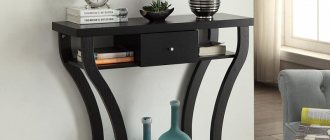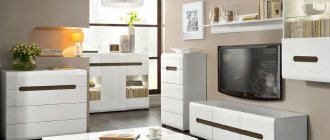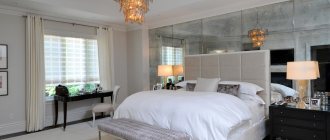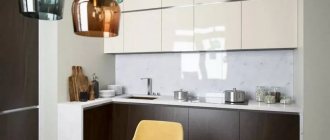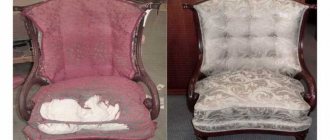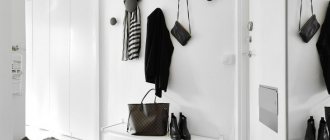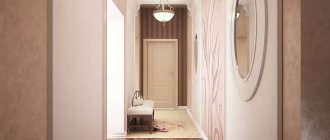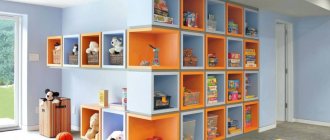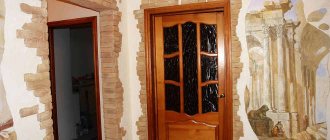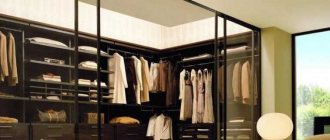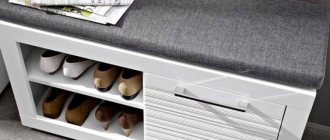Today, for many owners of small-sized housing, the issue related to the correct arrangement of a niche in the hallway is considered relevant, because this idea is an excellent alternative to huge cabinets. This is also an original decorative option, which, thanks to the play of tones, brings harmony to the room.
In addition to its decorative properties, the design can be used to adjust the perception of the area of the room.
An extraordinary design of a niche will give you the opportunity to abandon boring cabinets. Instead of purchasing cabinets for a niche in the hallway, the structure can be equipped with shelves for outdoor accessories and shoes.
To highlight such a decorative element, you can make spot lighting around its perimeter, arranged inside. For more elongated options, small ceiling lighting fixtures are suitable.
Advantages and disadvantages of built-in wardrobes
Pros of built-in wardrobes:
- They are often made to order according to individual projects, which allows you to choose design parameters, shape and color.
- The ability to hide a niche, corner and other non-standard layouts.
- Maximum capacity, ceiling height will increase the number of shelves for storing various things.
- The designs save space, sliding doors.
- A large selection of cabinet fronts for every taste to fit into any style.
- Reliable structures are tightly attached to the walls, the doors move smoothly on rollers.
- Minimal manufacturing costs; usually only a frame with doors is needed.
- Prices for the manufacture of sliding wardrobes are often lower than their cabinet counterparts. You can choose a luxurious facade design (mirrors, photo wallpaper, glass, etc.)
Furniture
The most difficult part of the hallway design work is furnishing. Small areas should be furnished in the spirit of minimalism, using built-in furniture. On a large square, a sofa would be appropriate. A standard set of boxes for storing shoes can be anything, the main thing is that it matches the room in color and shape.
Every hallway can be significantly improved with the right furniture. You can’t put a lot of it in the corridor, but there is always a way out. Therefore, for small corridors they came up with cabinets up to the ceiling, where everything you need fits behind mirrored doors.
Minuses
- The appearance and interior design of built-in wardrobes, thought out in small details, has virtually no downsides.
- The only drawback is the inability to move. When moving, you can dismantle it or leave it.
- If there is a strong desire to radically change the style of the interior, the facade material, pattern, etc. are changed.
Choosing the right finish
It’s hard to go wrong by calling wallpaper the most common finishing material for the walls of a modern hallway in a panel house. A remarkable fact: in an era of dominance of provocative designs and flashy tones, the good old classics continue to retain their charm and relevance.
In a dispute with ceramic tiles, even if laminate does not win, it continues to maintain stable parity. Its main advantages are ease of installation, good imitation of wood species, and high tactile comfort.
The combination of decorative plaster and classic wallpaper is found quite often in city apartments. Hallways decorated in this way radiate comfort and tranquility.
It’s quite possible to do without artificial stone in the hallway, but why, if it’s really better with it? This finishing material can be used both to decorate the entire wall of the room, and partially - in order to emphasize certain accents in the design.
Types of built-in wardrobes
Built-in models are the most convenient to save free space and add aesthetics to the room. The shapes of the facades are different:
- linear form - in a line along 1 wall;
- corner - occupies the depth of the corner, sometimes in the shape of a triangle with a facade along 1 line;
- wave - in the form of a wave;
- trapezoidal shape, where the side parts are beveled, can be panels, doors or shelves;
- five-walled - taking into account the walls of 5 sides of the cabinet;
- radius - with round doors.
Lighting and wall design
To decorate the hallway use:
- paintings depicting landscapes;
- a mirror that will visually increase the space of the room and allow you to look at yourself when leaving the house;
- family photos will add individualism.
The lighting system can be sconces on the wall or spotlights on the ceiling. Especially when it comes to suspended ceilings. There is no need for very bright lighting.
Volumetric chandeliers will only make the interior heavier. It is better to refuse them.
What should you pay attention to?
Location is the main condition for placing a built-in wardrobe:
- If there is a niche in the hallway (free wall), you will only need to install doors and fill the inside with rods, shelves and the necessary drawers.
- The best solution is built-in corner cabinets in the hallway. This will provide comfort for movement, storage capacity, and create beauty.
- A long wall in a narrow hallway; in addition to the facades, you will need a panel on the side.
Practical options
If there is not much space in the apartment, it would be more logical to use the niche for practical purposes - as a place for furniture or storing things. There are several options for what exactly can be placed in this small free space.
Clothes hanger
The most useful and necessary thing in the hallway is a coat hanger. So that it does not take up much space, it is worth hanging a crossbar or wall mount in a niche. Since the clothes will be in the recess, they will not take up free space in the room and will not attract attention.
Under the hanger you can install a cabinet or shelves for shoes, hooks for bags or drawers for hats, scarves and other accessories. This way, a narrow niche will become a full-fledged small dressing room, and getting ready for work or a walk will go much faster.
Closet
A large recess in the wall is an excellent option for installing a full-fledged cabinet. You can buy a ready-made one and place it in a recess, but it is more convenient to make a custom-made structure according to your own dimensions. Alternatively, do it yourself.
There is another interesting option - installing doors in a niche. It is better to choose a sliding door, as it does not take up much space and does not attract attention. You may prefer a model with a mirror. This simple technique will create the illusion of increasing the space in the room.
Narrow table
A small niche is a good option for installing a small table. Moreover, it can be either on legs or attached to the wall. The second model looks more concise and takes up less space. Suitable for rooms with small square footage.
On the table you can store various little things that you need every day: keys, sunglasses, gloves or mail. So, you no longer have to run around in the morning looking for these things - they will always be at hand.
Shelves
Small apartments often lack storage space. The recess in the wall is well suited to equip such an area. The specifics and design depend both on the space and on what items will be placed there. For example, these could be fresh flowers, books or photo frames.
Mirror
A good large mirror is an indispensable thing in the hallway, because before going out you want to see yourself in full height. A shallow narrow niche will be a suitable place to install it. You can choose a mirror strictly in size or a little smaller. It is better to install lamps in the side walls, thereby providing additional lighting in the room.
Wedge heel
A large bench or ottoman may take up too much space in the hallway. Therefore, such furniture should be installed in a niche. This solution has several advantages. The first is saving space. The second is ease of use. For example, putting on shoes or getting a small child ready for a walk will become much more convenient. If necessary, you can put a bag or something else on the pouf.
Glass with film
The inner side of the glass is protected by PVC film with various additives for strength. The façade can be glossy, matte or opaque.
The mosaic looks impressive. If the glass is accidentally damaged, there will be no injuries due to the absence of fragments.
Finishing materials
What to use to decorate the entrance area? The answer depends on the direction in the interior that was chosen as the main one. The loft style allows you to use natural stone, brick and painting. A modern style will require perfectly smooth walls, matte surfaces and plastic baseboards on the floor.
The floor at the front door can be decorated with tiles. The result is a bathroom that will not be difficult to keep clean.
Imitation stone is ideal for arches and openings. It’s better to make the ceiling of the hallway a single light canvas, so the space in it will become airier and wider.
To save space in the corridor, you can build a wardrobe. Then there will be even more space in it. And mirror surfaces are used in tiny corridors to solve problems with lighting and decoration there.
Plaster, wallpaper, laminate and plastic panels - in the hallway everything that can actually be used to decorate other rooms in the apartment is acceptable. Although there is one limitation that applies to most corridors. There it is better not to use floral wallpaper. They are incredibly forgiving of small to medium sized areas.
Floor
What could be the floor at the entrance? It is worth choosing the most practical and wear-resistant materials, because they will have to be washed quite often. For floor finishing, you can consider the following options:
- Laminate;
- Linoleum;
- Tile;
- Parquet;
- Carpet.
All of the above coatings have their own characteristics. Let's look at them in more detail:
| Coating | Peculiarities |
| Carpet | It gets dirty quickly, but looks expensive, requires frequent replacement due to regular abrasion, but holds liquid street dirt well. |
| Laminate | Does not tolerate moisture well, looks modern, fits any interior, and lasts a long time. |
| Parquet | Durable, but capricious material that requires careful care and a certain style in the interior. |
| Ceramic tile | A wear-resistant and durable option that is easy to care for. |
| Linoleum | Withstands almost any operating load, but has limitations in colors and patterns. Not suitable for all types of design. |
The choice of coating depends on the financial capabilities of the chooser, as well as on operating conditions. For a large family, where everyone leaves and comes from home several times a day, linoleum, tiles and laminate are suitable. For lower operational loads, carpet and parquet can be used.
Walls
The decoration of the walls in the corridor is of great importance. Like the bathtub, the corridor is subject to active use, so the walls there must be easy to clean and also withstand regular drafts.
A standard set of finishing materials for a hallway looks like this:
- Dye;
- Decorative plaster;
- Washable wallpaper;
- Cork;
- Stone and its imitation;
- Bamboo panels;
- PVC panels;
- Wooden panels;
- Mosaic or fresco.
Any type of the listed materials is easy to care for, lasts quite a long time, and looks presentable.
The finishing of the corridor should be carried out only with moisture-resistant and environmentally friendly materials. Otherwise, the repairs there will have to be redone in a year.
Combining materials for wall cladding is very popular. Wooden panels with wallpaper, stone and decorative plaster are the most common combinations in the interior of the hallway.
So 4 or 6 square meters will look much more interesting if you make niches on the walls and lay out mosaics. And the cork finishing method will be the most environmentally friendly, among others, if this notorious cork is placed correctly on the walls.
Ceiling
At the end of the 1970s, a standard series of houses p-44 was designed, with a ceiling height of 2.64 meters. This height is considered average, and with some interior ideas, it should be raised at least visually.
To make the ceiling in the hallway look higher, you need to choose a light shade for it. The layout in p44t is a little different from the houses of the 70s. According to the builders' plan, the ventilation duct is located in the hallway. With the height of the ceilings here, things are a little better; the standard height is 2.7 m. The design of a hallway with this height implies the possibility of playing with contrasts.
To decorate the ceiling, it is possible to use dark and light colors, stretch fabrics, plaster and stucco. Since the height of p44t allows this to be done.
But whatever the series of the house, plasterboard on the ceiling looks appropriate for ceilings of any height. Although simple painting also looks great.
Severe surface unevenness on the ceiling can be hidden only with hanging and overhead materials; when the ceiling is sufficiently smooth, painting and plaster are used to finish it.
In a large corridor, you can use a ceiling area to create a ceiling with transitions and projections. A small corridor always has straight lines and a minimum of details.
MDF and chipboard
Affordable cost makes them a popular material. DMF cladding is used in painted form, and drawings can be applied if desired. Laminated chipboards are also used.
A huge variety of built-in wardrobes in the hallway can be seen in the photo.
Design of a large hallway
Not all storey buildings are equipped with large corridors. But where the squares of the hallway allow, you can use the provided meters to maximum benefit.
For example, houses for animals are made in the corridor so as not to place them in the main hall. Or they install a small seating area with a sofa and armchairs to welcome guests.
Some manage to organize a sleeping place in a large hallway, which is hidden in a wall or closet during the day. An extraordinary approach helps large families solve the problem of lack of square footage for each person.
Cabinet interior
In addition to autumn-winter clothes and various shoes, there are many other things in compact storage. Inside the model:
- Standard or pull-out shelves for clothes. The height of the shelves is from 30 cm.
- Drawers for small items can be on rollers, which makes opening silent and smooth.
- Baskets (pull-out, built-in or roll-out) made of various materials. These are metal or plastic, wicker containers.
- A rod is needed for hanging outerwear. The length is chosen by the owner.
- Pantograph is a good solution for high-height cabinets. This will allow you to lower the bar to the desired height. There may be hangers and devices for ties, trousers, bags, scarves (kerchiefs), gloves, etc.
It is profitable to order a corner built-in wardrobe for the hallway; a professional craftsman will not only take measurements, but also suggest the best location, the depth of the cabinet and how to arrange the shelves inside.
Tiles in the corridor - pros and cons. Examples of corridor designClassic style in the hallway: finishing methods and design features
- Hallway design in apartments of panel houses
Often the shortcomings and non-standard layouts turn into the highlight of the room.
Design of a hallway with a storage room converted into a dressing room
In some corridors, storage rooms are located in the old fashioned way. Modern people no longer store car tires and jars of pickles there. They prefer to equip them as separate dressing rooms.
This solution allows you to avoid installing a separate closet in the hallway. And since the depth of such a pantry can be impressive, out-of-season items, boxes of shoes and any other accessories are placed in it.
A mirror in the doors of a former storage room will help transform it into a wardrobe. In addition, its doors can be disguised as the overall interior of the walls. And then every centimeter of the hallway will remain free for other interior solutions.
You can also install lighting in the former pantry to make choosing clothes as easy and pleasant as possible. Its interior decoration should be made similar to the exterior decor of the hallway. This way the corridor will acquire the most stylish and fashionable look.
The design of the hallway in a typical house is as complex as the design of the house area. It seems that a small space at the front door is quite easy to organize. But this statement is false, because the hallway is what guests see when entering the house, so it should be simply magnificent.
Repair and redevelopment in a panel house
Those who love a complete transformation of their personal space often undertake renovations and redevelopment. This implies:
- Partial or complete dismantling of walls and partitions;
- Redistribution of functional areas;
- Relocation of doorways;
- Combining the area of rooms;
- Expansion of some premises by reducing the area of others.
In order for a small hallway to meet the requirements, you should adhere to rules that can change its functionality and appearance.
It is not recommended to begin serious reconstruction without involving the services of construction companies. This is necessary so as not to risk the lives of the residents of the panel house. The essence of the redevelopment is the redistribution of the usable area of adjacent rooms, which will significantly transform the design of a small hallway in an apartment in a panel house.
It has been noticed that the use of dark colors when decorating a small room makes it gloomy and visually reduces its size.
Often, when modernizing a Khrushchev building, zoning techniques are used to separate functional corners. This can be a partial partition made of plasterboard or glass doors up to the ceiling. In addition to stationary partitions, this can be a folding bar counter between the hallway and the dining room, as is often done in a studio apartment.
Light shades expand the room, and mirrored or glossy surfaces push the boundaries even further, which is clearly visible in the photo.
Favorite design techniques for the reconstruction of panel houses include:
- Arches;
- Sides;
- Niches;
- Curved openings;
- Pass-through racks;
- Partitions in the form of a folding accordion.
These openings can be decorative elements, but often they are also shelves, seats and other functional interior elements.
Tips for organizing repairs and redevelopment.
- Make a plan for the hallway renovation.
- Take permission from the BTI and other supervisory authorities of the city government.
- Specify which walls are load-bearing and which are secondary.
- Plan to renovate two adjacent rooms at once, with the partition between them removed.
- Before demolishing the partition, turn off the lights and dismantle the electrical wiring on the wall for demolition.
- Plan new lighting.
- Think in advance about what the new floor covering will be like; most likely, you will have to adjust the screed and level the surface.
- The secondary part of the redevelopment is the choice of finishing materials and color scheme.
Decorating the walls and ceiling affects the entire design of the hallway in an apartment in a panel house. It is important to choose practical materials; on the floor, preferably abrasion-resistant coatings, such as porcelain tiles and moisture-resistant laminate.
Furniture should be purchased in the selected range or one or two tones different from the main color, unless a contrasting combination has become the finishing rule.
Don’t forget about techniques for visually enlarging small spaces. A well-thought-out lighting design, light cladding, photo wallpaper and mirrors will help with this. The priority is functional items and furniture with excellent aesthetic properties. As an example, see the photo of the design of a narrow corridor in an apartment in a panel house.
When choosing accessories and decor, try to buy ones that match the style of the interior.
See alsoHallway for a narrow corridor photo
